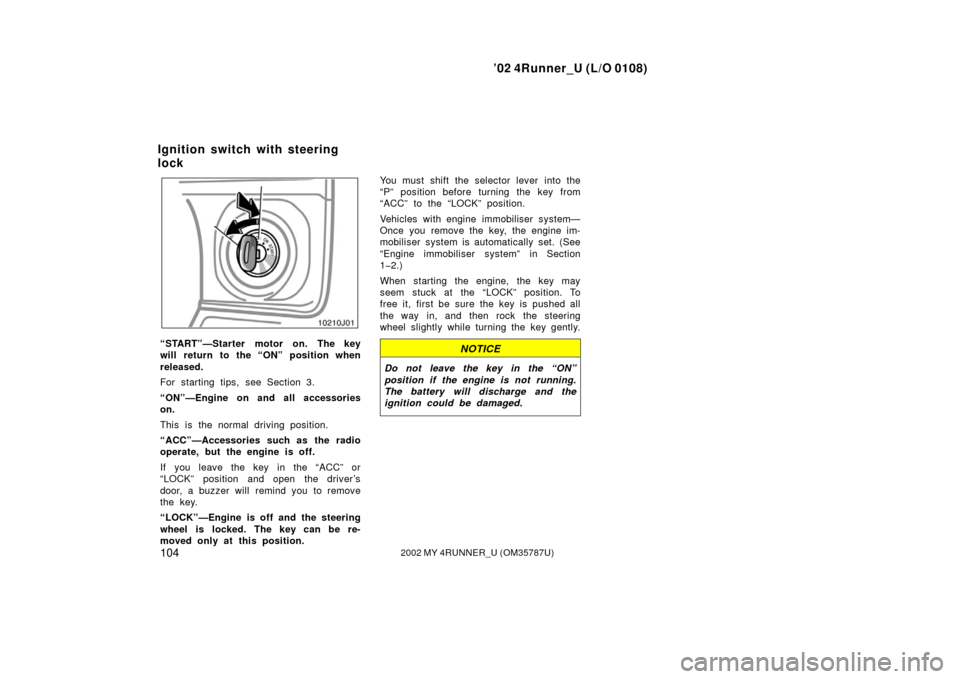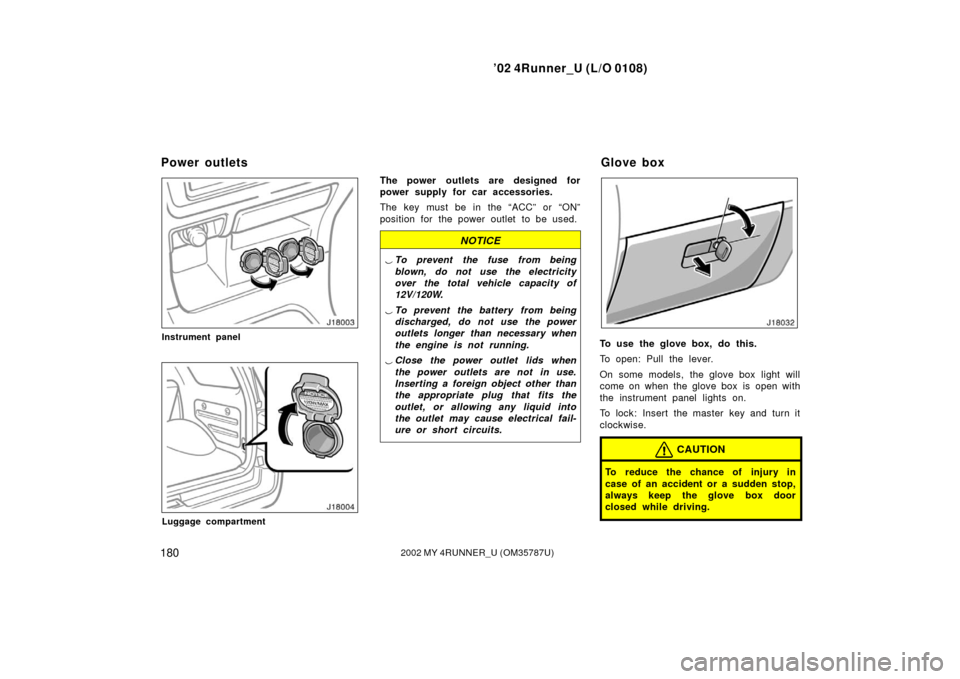Page 110 of 308

’02 4Runner_U (L/O 0108)
1042002 MY 4RUNNER_U (OM 35787U)
“START”—Starter motor on. The key
will return to the “ON” position when
released.
For starting tips, see Section 3.
“ON”—Engine on and all accessories
on.
This is the normal driving position.
“ACC”—Accessories such as the radio
operate, but the engine is off.
If you leave the key in the “ACC” or
“LOCK” position and open the driver’s
door, a buzzer will remind you to remove
the key.
“LOCK”—Engine is off and the steering
wheel is locked. The key can be re-
moved only at this position. You must shift the selector lever into the
“P” position before turning the key from
“ACC” to the “LOCK” position.
Vehicles with engine immobiliser system—
Once you remove the key, the engine im-
mobiliser system is automatically set. (See
“Engine immobiliser system” in Section
1�2.)
When starting the engine, the key may
seem stuck at the “LOCK” position. To
free it, first be sure the key is pushed all
the way in, and then rock the steering
wheel slightly while turning the key gently.NOTICE
Do not leave the key in the “ON”
position if the engine is not running.
The battery will discharge and the
ignition could be damaged.
Ignition switch with steering
lock
Page 186 of 308

’02 4Runner_U (L/O 0108)
1802002 MY 4RUNNER_U (OM 35787U)
Instrument panel
Luggage compartment
The power outlets are designed for
power supply for car accessories.
The key must be in the “ACC” or “ON”
position for the power outlet to be used.
NOTICE
�To prevent the fuse from being
blown, do not use the electricity
over the total vehicle capacity of
12V/120W.
� To prevent the battery from being
discharged, do not use the power
outlets longer than necessary when
the engine is not running.
� Close the power outlet lids when
the power outlets are not in use.
Inserting a foreign object other than
the appropriate plug that fits the
outlet, or allowing any liquid into
the outlet may cause electrical fail-
ure or short circuits.
To use the glove box, do this.
To open: Pull the lever.
On some models, the glove box light will
come on when the glove box is open with
the instrument panel lights on.
To lock: Insert the master key and turn it
clockwise.
CAUTION
To reduce the chance of injury in
case of an accident or a sudden stop,
always keep the glove box door
closed while driving.
Power outlets Glove box
Page 230 of 308

’02 4Runner_U (L/O 0108)
2242002 MY 4RUNNER_U (OM 35787U)
Before making these checks, make sure
you have followed the correct starting
procedure given in “How to start the
engine” in Section 3 and that you have
sufficient fuel. If your vehicle is equipped
with the engine immobiliser system, also
check whether the other keys will start the
engine. If they work, your key may be
broken. Have the key checked at your
Toyota dealer. If none of your keys work,
the system is possibly broken. Call your
Toyota dealer. (See “Keys (with engine
immobiliser system)” in Section 1�2.)
If the engine is not turning over or is
turning over too slowly—
1. Check that the battery terminals are tight and clean.
2. If the battery terminals are O.K., switch on the interior light.
3. If the light is out, dim or goes out when the starter is cranked, the battery
is discharged. You may try jump start-
ing. See “(c) Jump starting” for further
instructions.
If the light is O.K., but the engine still will
not start, it needs adjustment or repair.
Call a Toyota dealer or qualified repair
shop.NOTICE
Do not pull� or push�start the ve-
hicle. It may damage the vehicle or
cause a collision when the engine
starts. Also the three�way catalytic
converter may overheat and become a
fire hazard.
If the engine turns over at its normal
speed but will not start— 1. The engine may be flooded because of repeated cranking. See “(b) Starting a
flooded engine” for further instructions.
2. If the engine still will not start, it needs adjustment or repair. Call a Toyota
dealer or qualified repair shop. If the engine will not start, your engine
may be flooded because of repeated
cranking.
If this happens, turn the key to “START”
with the accelerator pedal held down.
Keep the key and accelerator pedal in
these position for 15 seconds and release
them. Then try starting the engine with
your foot off the accelerator pedal.
If the engine does not start after 15 se-
conds of cranking, release the key, wait
a few minutes and try again.
If the engine still will not start, it needs
adjustment or repair. Call a Toyota dealer
or qualified repair shop for assistance.
NOTICE
Do not crank for more than 30 se-
conds at a time. This may overheat
the starter and wiring systems.
If your vehicle will not start—
(a) Simple checks
(b) Starting a flooded engine
Page 233 of 308

’02 4Runner_U (L/O 0108)
2272002 MY 4RUNNER_U (OM 35787U)
5. Start your engine in the normal way.
After starting, run it at about 2000 rpm
for several minutes with the accelerator
pedal lightly depressed.
6. Carefully disconnect the cables in the exact reverse order: the negative cable
and then the positive cable.
7. Carefully dispose of the battery cover cloths—they may now contain sulfuric
acid.
8. If removed, replace all the battery vent plugs.
If the cause of your battery discharging is
not apparent (for example, lights left on),
you should have it checked. If your engine stalls while driving...
1. Reduce your speed gradually, keeping a straight line. Move cautiously off the
road to a safe place.
2. Turn on your emergency flashers.
3. Try starting the engine again.
If the engine will not start, see “If your
vehicle will not start”.
CAUTION
If the engine is not running, the pow-
er assist for the brakes and steering
will not work so steering and braking
will be much harder than usual.
If the engine speed does not increase with
the accelerator pedal depressed down to
about the middle position , there may be a
problem somewhere in your electronic
throttle control system.
At this time, if you depress the accelera-
tor pedal more firmly and slowly, you can
drive you vehicle at low speeds. Have
your vehicle checked by your Toyota deal-
er as soon as possible.
Even if the abnormality of the electronic
throttle control system is corrected during
low speed driving, the system may not be
recovered until the engine is stopped and
the ignition key is turned to “ACC” or
“LOCK” position.
CAUTION
Be especially careful to prevent erro-
neous pedal operation.
If your engine stalls while
driving If you cannot incr
ease the
engine speed
Page 296 of 308

’02 4Runner_U (L/O 0108)
2902002 MY 4RUNNER_U (OM 35787U)
COOLING SYSTEM
Total capacity, L (qt., Imp. qt.):
With rear heater 9.0 (9.5, 7.9)
Without rear heater 8.0 (8.5, 7.0)
Coolant type:
“TOYOTA Long Life Coolant” or equiva-
lent
With ethylene�glycol type coolant for a
proper corrosion protection of aluminum
components
Do not use alcohol type antifreeze or
plain water alone.
BATTERY
Open voltage
∗ at 20 �C (68 �F):
12.6—12.8 V Fully charged
12.2—12.4 V Half charged
11.8—12.0 V Discharged
∗: Voltage that is checked 20 minutes af- ter the key is removed with all the
lights turned off
Charging rates: 5 A max. AUTOMATIC TRANSMISSION
Fluid capacity (drain and ref
ill),
L (qt., Imp. qt.):
Two�wheel drive modelsUp to 1.6 (1.7, 1.4)
Four�wheel drive models Up to 2.0 (2.1, 1.8)
Fluid type: Automatic transmission fluid D�II or
DEXRON �III (DEXRON �II)
TRANSFER
Oil capacity, L (qt., Imp. qt.): 1.2 (1.3, 1.1)
Oil type: Gear oil API GL�4 or GL�5
Recommended oil viscosity: SAE 75W�90 DIFFERENTIAL
Oil capacity, L (qt., Imp. qt.):
Two�wheel drive models2.75 (2.9, 2.4)
Four�wheel drive models Front1.15 (1.2, 1.0)
Rear
With center differential lock system2.75 (2.9, 2.4)
Without center differential lock sys-
tem 2.45 (2.6, 2.2)
Oil type: Hypoid gear oil API GL�5
Recommended oil viscosity:
FrontSAE 75W�90
Rear Above �18 �C (0 �F)
SAE 90
Below �18 �C (0 �F)
SAE 80W or 80W�90